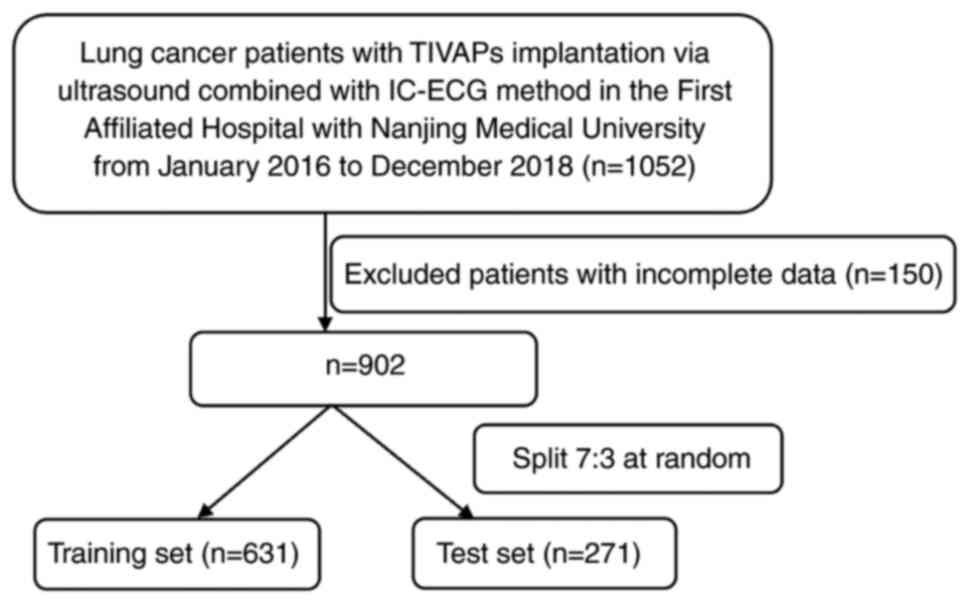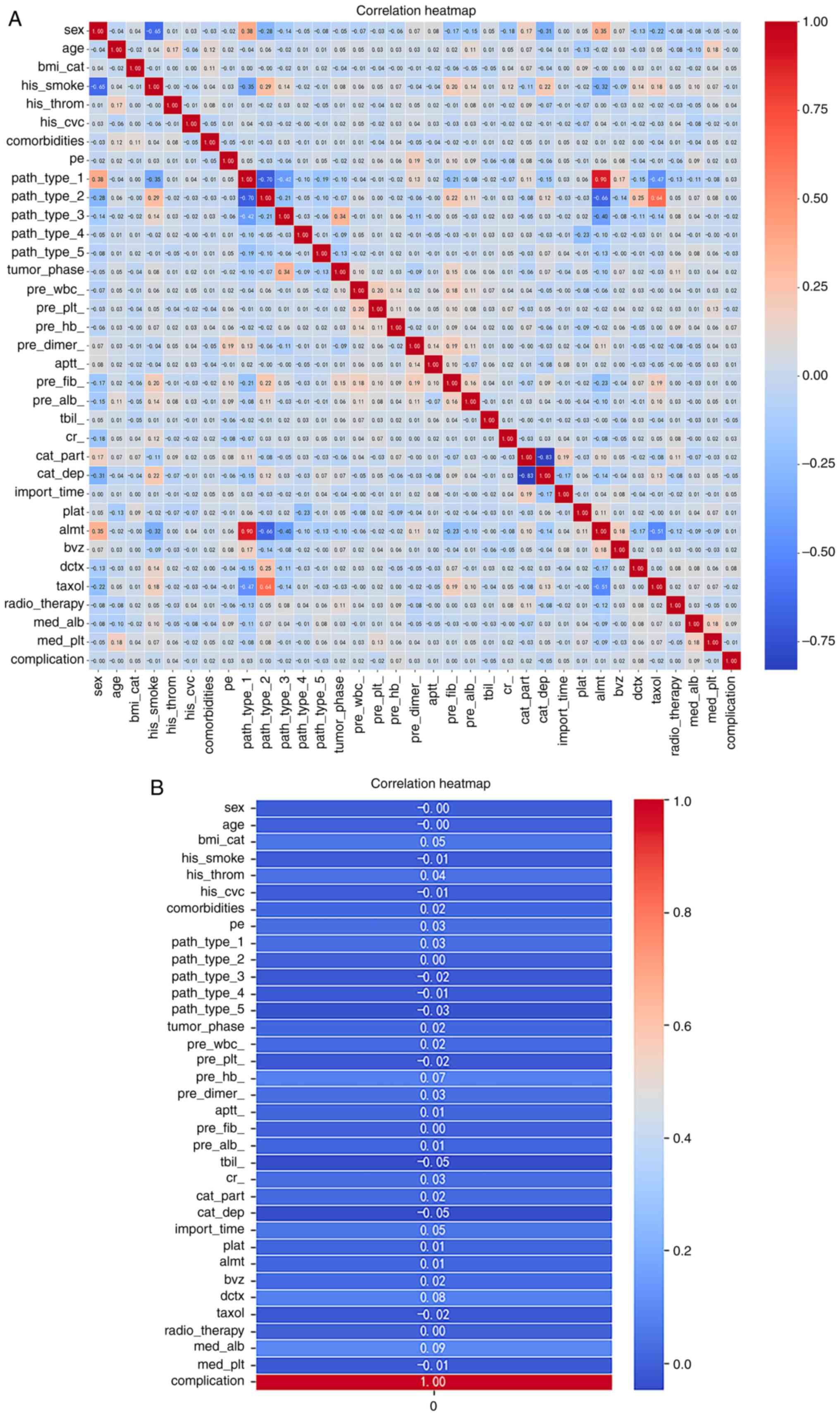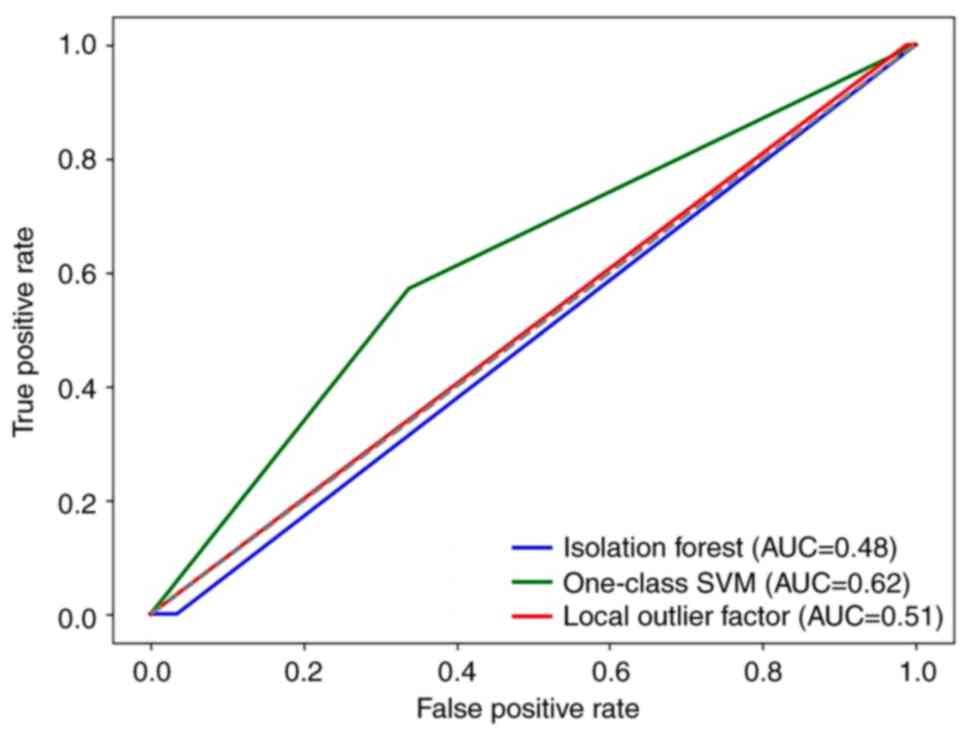|
1
|
Abdel-Rahman O: Changing epidemiology of
elderly small cell lung cancer patients over the last 40 years; a
SEER database analysis. Clin Respir J. 12:1093–1099. 2018.
View Article : Google Scholar : PubMed/NCBI
|
|
2
|
Gallieni M, Pittiruti M and Biffi R:
Vascular access in oncology patients. CA Cancer J Clin. 58:323–346.
2008. View Article : Google Scholar : PubMed/NCBI
|
|
3
|
Silberzweig JE, Sacks D, Khorsandi AS and
Bakal CW; Society of Interventional Radiology Technology Assessment
Committee, : Reporting standards for central venous access. J Vasc
Interv Radiol. 14((9 Pt 2)): S443–S452. 2003. View Article : Google Scholar : PubMed/NCBI
|
|
4
|
Nayeemuddin M, Pherwani AD and Asquith JR:
Imaging and management of complications of central venous
catheters. Clin Radiol. 68:529–544. 2013. View Article : Google Scholar : PubMed/NCBI
|
|
5
|
Maki DG, Kluger DM and Crnich CJ: The risk
of bloodstream infection in adults with different intravascular
devices: A systematic review of 200 published prospective studies.
Mayo Clin Proc. 81:1159–1171. 2006. View Article : Google Scholar : PubMed/NCBI
|
|
6
|
Yeow M, Soh S, Yap R, Tay D, Low YF, Goh
SSN, Yeo CS and Lo ZJ: A systematic review and network
meta-analysis of randomized controlled trials on choice of central
venous access device for delivery of chemotherapy. J Vasc Surg
Venous Lymphat Disord. 10:1184–1191.e8. 2022. View Article : Google Scholar : PubMed/NCBI
|
|
7
|
Walser EM: Venous access ports:
Indications, implantation technique, follow-up, and complications.
Cardiovasc Intervent Radiol. 35:751–764. 2012. View Article : Google Scholar : PubMed/NCBI
|
|
8
|
Tabatabaie O, Kasumova GG, Eskander MF,
Critchlow JF, Tawa NE and Tseng JF: Totally implantable venous
access devices: A review of complications and management
strategies. Am J Clin Oncol. 40:94–105. 2017. View Article : Google Scholar : PubMed/NCBI
|
|
9
|
Voog E, Campion L, du Rusquec P, Bourgeois
H, Domont J, Denis F, Emmanuel E, Dupuis O, Ganem G, Lafont C, et
al: Totally implantable venous access ports: A prospective
long-term study of early and late complications in adult patients
with cancer. Support Care Cancer. 26:81–89. 2018. View Article : Google Scholar : PubMed/NCBI
|
|
10
|
Lebeaux D, Fernández-Hidalgo N, Chauhan A,
Lee S, Ghigo JM, Almirante B and Beloin C: Management of infections
related to totally implantable venous-access ports: Challenges and
perspectives. Lancet Infect Dis. 14:146–159. 2014. View Article : Google Scholar : PubMed/NCBI
|
|
11
|
Wildgruber M, Borgmeyer S, Haller B,
Jansen H, Gaa J, Kiechle M, Meier R, Ettl J and Berger H:
Short-term and long-term outcome of radiological-guided insertion
of central venous access port devices implanted at the forearm: A
retrospective monocenter analysis in 1704 patients. Eur Radiol.
25:606–616. 2015. View Article : Google Scholar : PubMed/NCBI
|
|
12
|
Rouzrokh M, Shamsian BS, Tabari A,
Mahmoodi M, Kouranlo J, Manafzadeh G, Arzanian MT, Fallah F, Anoush
M and Gorji FA: Totally implantable subpectoral vs. subcutaneous
port systems in children with malignant diseases. Arch Iran Med.
12:389–394. 2009.PubMed/NCBI
|
|
13
|
Peiffer-Smadja N, Rawson TM, Ahmad R,
Buchard A, Georgiou P, Lescure FX, Birgand G and Holmes AH: Machine
learning for clinical decision support in infectious diseases: A
narrative review of current applications. Clin Microbiol Infect.
26:584–595. 2020. View Article : Google Scholar : PubMed/NCBI
|
|
14
|
Reel PS, Reel S, Pearson E, Trucco E and
Jefferson E: Using machine learning approaches for multi-omics data
analysis: A review. Biotechnol Adv. 49:1077392021. View Article : Google Scholar : PubMed/NCBI
|
|
15
|
Vamathevan J, Clark D, Czodrowski P,
Dunham I, Ferran E, Lee G, Li B, Madabhushi A, Shah P, Spitzer M
and Zhao S: Applications of machine learning in drug discovery and
development. Nat Rev Drug Discov. 18:463–477. 2019. View Article : Google Scholar : PubMed/NCBI
|
|
16
|
Mooney SJ and Pejaver V: Big data in
public health: Terminology, machine learning, and privacy. Annu Rev
Public Health. 39:95–112. 2018. View Article : Google Scholar : PubMed/NCBI
|
|
17
|
Alloqmani A, Abushark YB and Khan AI:
Anomaly detection of breast cancer using deep learning. Arab J Sci
Eng. 12:1–26. 2023.PubMed/NCBI
|
|
18
|
Pittiruti M, Pelagatti F and Pinelli F:
Intracavitary electrocardiography for tip location during central
venous catheterization: A narrative review of 70 years of clinical
studies. J Vasc Access. 22:778–785. 2021. View Article : Google Scholar : PubMed/NCBI
|
|
19
|
Liu Z, Zheng X, Zhen Y, Liu X, Lin F, Ye Z
and Liu P: Efficacy, safety, and cost-effectiveness of
intracavitary electrocardiography-guided catheter tip placement for
totally implantable venous access port. Ann Vasc Surg. 83:168–175.
2022. View Article : Google Scholar : PubMed/NCBI
|
|
20
|
Bell T and O'Grady NP: Prevention of
central line-associated bloodstream infections. Infect Dis Clin
North Am. 31:551–559. 2017. View Article : Google Scholar : PubMed/NCBI
|
|
21
|
Baskin JL, Pui CH, Reiss U, Wilimas JA,
Metzger ML, Ribeiro RC and Howard SC: Management of occlusion and
thrombosis associated with long-term indwelling central venous
catheters. Lancet. 374:159–169. 2009. View Article : Google Scholar : PubMed/NCBI
|
|
22
|
Chang YF, Lo AC, Tsai CH, Lee PY, Sun S,
Chang TH, Chen CC, Chang YS and Chen JR: Higher complication risk
of totally implantable venous access port systems in patients with
advanced cancer-a single institution retrospective analysis.
Palliat Med. 27:185–191. 2013. View Article : Google Scholar : PubMed/NCBI
|
|
23
|
Goltz JP, Schmid JS, Ritter CO, Knödler P,
Petritsch B, Kirchner J, Hahn D and Kickuth R: Identification of
risk factors for catheter-related thrombosis in patients with
totally implantable venous access ports in the forearm. J Vasc
Access. 13:79–85. 2012. View Article : Google Scholar : PubMed/NCBI
|
|
24
|
Ma LI, Liu Y, Wang J, Chang Y, Yu L and
Geng C: Totally implantable venous access port systems and
associated complications: A single-institution retrospective
analysis of 2,996 breast cancer patients. Mol Clin Oncol.
4:456–460. 2016. View Article : Google Scholar : PubMed/NCBI
|
|
25
|
Vidal M, Genillon JP, Forestier E,
Trouiller S, Pereira B, Mrozek N, Aumeran C and Lesens O: Outcome
of totally implantable venous-access port-related infections. Med
Mal Infect. 46:32–38. 2016. View Article : Google Scholar : PubMed/NCBI
|
|
26
|
Skummer P, Kobayashi K, DeRaddo JS,
Blackburn T, Schoeneck M, Patel J and Jawed M: Risk factors for
early port infections in adult oncologic patients. J Vasc Interv
Radiol. 31:1427–1436. 2020. View Article : Google Scholar : PubMed/NCBI
|
|
27
|
Wang YC, Lin PL, Chou WH, Lin CP and Huang
CH: Long-term outcomes of totally implantable venous access
devices. Support Care Cancer. 25:2049–2054. 2017. View Article : Google Scholar : PubMed/NCBI
|
|
28
|
Tsuruta S, Goto Y, Miyake H, Nagai H,
Yoshioka Y, Yuasa N and Takamizawa J: Late complications associated
with totally implantable venous access port implantation via the
internal jugular vein. Support Care Cancer. 28:2761–2768. 2020.
View Article : Google Scholar : PubMed/NCBI
|
|
29
|
Lin WY, Lin CP, Hsu CH, Lee YH, Lin YT,
Hsu MC and Shao YY: Right or left? Side selection for a totally
implantable vascular access device: A randomised observational
study. Br J Cancer. 26:932–937. 2017. View Article : Google Scholar
|
|
30
|
Tian L, Li W, Su Y, Gao H, Yang Q, Lin P,
Wang L, Zeng J and Li Y: Risk factors for central venous access
device-related thrombosis in hospitalized children: A systematic
review and meta-analysis. Thromb Haemost. 121:625–640. 2021.
View Article : Google Scholar : PubMed/NCBI
|
|
31
|
Intagliata E, Basile F and Vecchio R:
Totally implantable catheter migration and its percutaneous
retrieval: Case report and review of the literature. G Chir.
37:n211–n215. 2017.PubMed/NCBI
|
|
32
|
Chen Y, Tsang YS, Chou X, Hu J and Xia Q:
A lung cancer patient with deep vein thrombosis: A case report and
literature review. BMC Cancer. 19:2852019. View Article : Google Scholar : PubMed/NCBI
|
|
33
|
Travis WD, Brambilla E, Nicholson AG,
Yatabe Y, Austin JHM, Beasley MB, Chirieac LR, Dacic S, Duhig E,
Flieder DB, et al: The 2015 world health organization
classification of lung tumors: Impact of genetic, clinical and
radiologic advances since the 2004 classification. J Thorac Oncol.
10:1243–1260. 2015. View Article : Google Scholar : PubMed/NCBI
|
|
34
|
Goldstraw P, Chansky K, Crowley J,
Rami-Porta R, Asamura H, Eberhardt WE, Nicholson AG, Groome P,
Mitchell A, Bolejack V, et al: The IASLC lung cancer staging
project: Proposals for revision of the TNM stage groupings in the
forthcoming (Eighth) edition of the TNM classification for lung
cancer. J Thorac Oncol. 11:39–51. 2016. View Article : Google Scholar : PubMed/NCBI
|
|
35
|
Foorthuis R: On the nature and types of
anomalies: A review of deviations in data. Int J Data Sci Anal.
12:297–331. 2021. View Article : Google Scholar : PubMed/NCBI
|
|
36
|
Arnaout R, Curran L, Zhao Y, Levine JC,
Chinn E and Moon-Grady AJ: An ensemble of neural networks provides
expert-level prenatal detection of complex congenital heart
disease. Nat Med. 27:882–891. 2021. View Article : Google Scholar : PubMed/NCBI
|
|
37
|
Kim B, Kwon K, Oh C and Park H:
Unsupervised anomaly detection in MR images using multicontrast
information. Med Phys. 48:7346–7359. 2021. View Article : Google Scholar : PubMed/NCBI
|
|
38
|
Karadayi Y, Aydin MN and Ogrenci AS:
Unsupervised anomaly detection in multivariate spatio-temporal data
using deep learning: Early detection of COVID-19 outbreak in Italy.
IEEE Access. 8:164155–164177. 2020. View Article : Google Scholar : PubMed/NCBI
|
|
39
|
Guo Y, Jiang X, Tao L, Meng L, Dai C, Long
X, Wan F, Zhang Y, van Dijk J, Aarts RM, et al: Epileptic seizure
detection by cascading isolation forest-based anomaly screening and
easyensemble. IEEE Trans Neural Syst Rehabil Eng. 30:915–924. 2022.
View Article : Google Scholar : PubMed/NCBI
|
|
40
|
Lin CH, Hsu KC, Johnson KR, Luby M and
Fann YC: Applying density-based outlier identifications using
multiple datasets for validation of stroke clinical outcomes. Int J
Med Inform. 132:1039882019. View Article : Google Scholar : PubMed/NCBI
|
|
41
|
Mei S and Zhu H: A novel one-class SVM
based negative data sampling method for reconstructing
proteome-wide HTLV-human protein interaction networks. Sci Rep.
5:80342015. View Article : Google Scholar : PubMed/NCBI
|
|
42
|
Schölkopf B, Platt JC, Shawe-Taylor J,
Smola AJ and Williamson RC: Estimating the support of a
high-dimensional distribution. Neural Comput. 13:1443–1471. 2001.
View Article : Google Scholar : PubMed/NCBI
|
|
43
|
Wildgruber M, Lueg C, Borgmeyer S, Karimov
I, Braun U, Kiechle M, Meier R, Koehler M, Ettl J and Berger H:
Polyurethane versus silicone catheters for central venous port
devices implanted at the forearm. Eur J Cancer. 59:113–124. 2016.
View Article : Google Scholar : PubMed/NCBI
|
|
44
|
Xu M, Deng L, Zhu Y, Li Y, Wang F, Li H
and Zhou Y: Risk factors of catheter-related infection in unplanned
extubation of totally implantable venous-accessportsin tumor
patients. Emerg Med Int. 2022:42353162022. View Article : Google Scholar : PubMed/NCBI
|
|
45
|
Narducci F, Jean-Laurent M, Boulanger L,
El Bedoui S, Mallet Y, Houpeau JL, Hamdani A, Penel N and Fournier
C: Totally implantable venous access port systems and risk factors
for complications: A one-year prospective study in a cancer centre.
Eur J Surg Oncol. 37:913–918. 2011. View Article : Google Scholar : PubMed/NCBI
|
|
46
|
Liu Y, Li LL, Xu L, Feng DD, Cao Y, Mao
XY, Zheng J, Jin F and Chen B: Comparison between arm port and
chest port for optimal vascular access port in patients with breast
cancer: A systematic review and meta-analysis. Biomed Res Int.
2020:90829242020.PubMed/NCBI
|
|
47
|
Khorana AA, Kuderer NM, Culakova E, Lyman
GH and Francis CW: Development and validation of a predictive model
for chemotherapy-associated thrombosis. Blood. 111:4902–4907. 2008.
View Article : Google Scholar : PubMed/NCBI
|
|
48
|
Wabont G, Bergeron S, Gautier S and Barus
R: Sex differences in serious adverse drug reactions in patients
receiving immunotherapy, targeted therapy, or chemotherapy: A
disproportionality analysis of the VigiBase(R). Eur J Clin
Pharmacol. 78:1355–1356. 2022. View Article : Google Scholar : PubMed/NCBI
|
|
49
|
Decousus H, Bourmaud A, Fournel P,
Bertoletti L, Labruyere C, Presles E, Merah A, Laporte S, Stefani
L, Piano FD, et al: Cancer-associated thrombosis in patients with
implanted ports: A prospective multicenter French cohort study
(ONCOCIP). Blood. 132:707–716. 2018. View Article : Google Scholar : PubMed/NCBI
|












